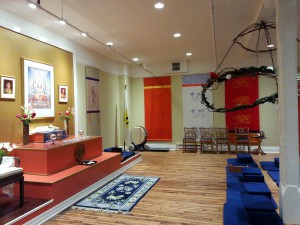Sunday
Community ArticlesBecoming Who We Want to Be: Toronto Shambhala, Part 2
COLUMN: Shambhala on the Move
by Margaret May
This is part two of a two-part series on the tale of the transformation of the Toronto Shambhala Center. Click here for Part One.
 September 2013: It is a Tuesday night, about fifteen minutes before sitting and instruction begins. In the Community Room, the late sun streams through the windows, the Shambhala Crest banner proclaims itself on the wall. Several people are sitting on one of the new benches, turned to each other. A group of people on colourful chairs and upholstered ottomans are chatting, gathered around the coffee table. Others stand in front of the bookstore alcove just inside the door, and the greeter shows people to the coat room. The energy is vibrant. The centre hums with a bright new friendliness.
September 2013: It is a Tuesday night, about fifteen minutes before sitting and instruction begins. In the Community Room, the late sun streams through the windows, the Shambhala Crest banner proclaims itself on the wall. Several people are sitting on one of the new benches, turned to each other. A group of people on colourful chairs and upholstered ottomans are chatting, gathered around the coffee table. Others stand in front of the bookstore alcove just inside the door, and the greeter shows people to the coat room. The energy is vibrant. The centre hums with a bright new friendliness.
By redefining space (removing walls and interior design elements), relocating functions (e.g., storage), and rethinking how we do things, we’ve created a more spacious, relaxed, open, and welcoming environment. At first it felt so audacious and radical to knock out a wall but by the time it’s completed, it seems like a no brainer.
December 2014: Someone leans through the Main Shrine Room doors, remarking, “Wow. I love the colour.” A former director says, “Now it looks like what we are teaching.” There is some sadness too, rooted in fondness for the room in which we all began this path.
 There were two weeks of really intense hard work by thirty volunteers and four member contractors—demolishing, repairing, installing pot lights and new baseboards, reframing the shrine, painting, and more painting. We send out progress bulletins with pictures by e-mail. Comments and stories come back in response. Some of the decisions are mildly controversial, undoing what were momentous decisions made decades ago. Did we check with people who really know? Revered teachers had advised on this element—are we sure we should change it? What does Eva Wong say? “The Sakyong recommends that Shambhala Centers should be light, simple, and bright” she says. As we take apart the old room we appreciate the incredible effort of those who had created a strong and powerful shrine room from the original greasy bones of a machine shop almost thirty years ago.
There were two weeks of really intense hard work by thirty volunteers and four member contractors—demolishing, repairing, installing pot lights and new baseboards, reframing the shrine, painting, and more painting. We send out progress bulletins with pictures by e-mail. Comments and stories come back in response. Some of the decisions are mildly controversial, undoing what were momentous decisions made decades ago. Did we check with people who really know? Revered teachers had advised on this element—are we sure we should change it? What does Eva Wong say? “The Sakyong recommends that Shambhala Centers should be light, simple, and bright” she says. As we take apart the old room we appreciate the incredible effort of those who had created a strong and powerful shrine room from the original greasy bones of a machine shop almost thirty years ago.
Renovating the Rigden Shrine Room has a different energy to it. In this second phase of our renovation, the room we are working with is rich with colours of blue, red, turquoise, and maroon. There are extended platforms and faux columns, a canopy over the shrine. We are keenly aware of the room’s power and are sensitive to the possibility that the change we’ve set in motion is also a loss of something important. Will it be powerful in its own new way? As we pare down and remove the built structures, we discover new possibilities and unforeseen needs. We wait to feel what to do. Innovations arise. There is a structural support post in the centre of the room, painted in a particular way. Should we paint over it or not? The maroon post stands still. The colours in the room change and the room opens up. Yes, we decide to paint it. I chant “Om Mani Padme Hum” as the first sweep of white goes on.
Children’s Day is fast approaching and we can start cleaning. Somehow the worn and beaten up floor burnished years ago by other volunteers glows in a way we haven’t seen before. We hang the Four Dignities banners for the first time in our centre. The Rigden Shrine Room manifests enlightened society. Light pours through the unobstructed windows. The space feels, open, simple, elegant, and bright.
It feels awake and alive—like we do.
~~
 Margaret May is a student of Sakyong Mipham and is active in three of the four pillars of Shambhala. She currently holds the position of Director of the Toronto centre, where she feels honoured to be part of a community inspired by the Sakyong and the Shambhala teachings. Being involved with the Sacred Space Team was a delightful experience for Margaret—particularly in terms of learning that when one lets go, brilliance arises. She is thrilled by the spontaneity and joy of her three- and one-year-old granddaughters. Margaret worked in the cultural sector for 30 years, more than half of which as a planner for an international museum-planning firm.
Margaret May is a student of Sakyong Mipham and is active in three of the four pillars of Shambhala. She currently holds the position of Director of the Toronto centre, where she feels honoured to be part of a community inspired by the Sakyong and the Shambhala teachings. Being involved with the Sacred Space Team was a delightful experience for Margaret—particularly in terms of learning that when one lets go, brilliance arises. She is thrilled by the spontaneity and joy of her three- and one-year-old granddaughters. Margaret worked in the cultural sector for 30 years, more than half of which as a planner for an international museum-planning firm.
















